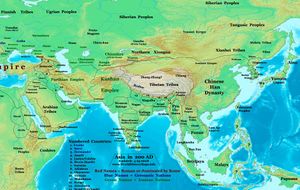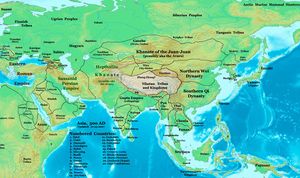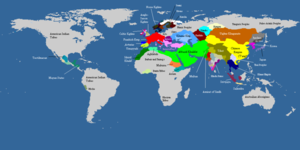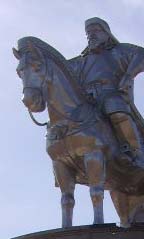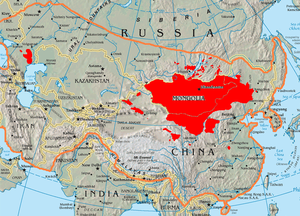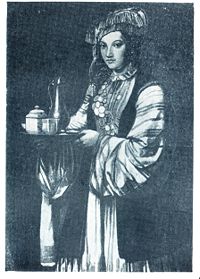تاريخ منغوليا
| جزء من سلسلة عن | ||||||||||||||
| تاريخ منغوليا | ||||||||||||||
|---|---|---|---|---|---|---|---|---|---|---|---|---|---|---|
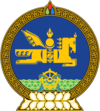 | ||||||||||||||
| الفترة القديمة | ||||||||||||||
|
||||||||||||||
| العصور الوسطى | ||||||||||||||
|
||||||||||||||
| الفترة المعاصرة | ||||||||||||||
|
||||||||||||||
| موضوعات | ||||||||||||||
|
| ||||||||||||||
اتحدت عدة مجموعات من المغول تحت قيادة جنكيزخان في بداية القرن الثاني عشر الميلادي. وقد وسع جنكيزخان وحفيده قبلاي خان الإمبراطورية المغولية من كوريا والصين باتجاه الغرب حتى وصلا إلى أوروبا. وقد انهارت هذه الإمبراطورية في نهاية القرن الثالث عشر الميلادي. . وقد أعاد أمراء المغول توحيد منغوليا في نهاية القرن الخامس عشر الميلادي، وأمروا الناس باعتناق عقيدة اللاما. وفي بداية القرن السادس عشر الميلادي، سيطر حكام شعب منشوريا المنغوليون على منغوليا الداخلية. وقد انتصر هؤلاء الحكام على الصين في عام 1644م واستولوا على منغوليا الخارجية في عام1680م.
ولم يكن لمنغوليا ـ كما هي الحال بالنسبة إلى الصين ـ سوى اتصالات محدودة مع الشعوب الأخرى خلال القرنين السابع عشر والثامن عشر الميلاديين. انظر: منشوريا.
وفي عام 1911م، طرد المنغوليون القوات الصينية من منغوليا الخارجية ونصبوا قديسا يدعى بوذا الحي ملكًا، وطلبوا دعمًا من روسيا.
وفي عام 1913م، وافقت كل من الصين وروسيا على إعطاء منغوليا الخارجية السيادة على شؤونها، لكنها مع ذلك بقيت مقاطعة صينية من الناحية القانونية، وفي الواقع تحت السيطرة الروسية. وخلال الحرب الأهلية الروسية عام 1920م احتلت القوات المناوئة للشيوعية منغوليا الخارجية، وحكمتها من خلال تنصيب بوذا الحي ملكًا عليها. ثم استولى المنغوليون والشيوعيون الروس على منغوليا الخارجية في عام 1921م وأنشأوا جمهورية منغوليا الشعبية في عام 1924م بعد وفاة بوذا الحي.
ساندت منغوليا الاتحاد السوفييتي أثناء الصراع السوفييتي الصيني حول قيادة العالم الشيوعي.
وفي نهاية الثمانينيات، أعطت الإصلاحات التي حدثت في الاتحاد السوفييتي ودول أوروبا الشرقية حريات لأكثر شعوب هذه الدول. وقد قاد المنغوليون مظاهرات في عام 1990م من أجل الحصول على مزيد من الحريات متأثرين بالتغيرات التي حدثت في الدول الشيوعية الأخرى. ونتيجة لذلك، تخلى الحزب الشيوعي في منغوليا عن احتكاره السلطة وتم تبني نظام التعددية الحزبية.
أجريت انتخابات حرة في شهر يوليو عام 1990م، وفاز الشيوعيون بأغلبية مقاعد البرلمان. وفي عام 1992م، أجريت انتخابات أخرى في أعقاب حل الحزب الشيوعي. وقد فاز الحزب الثوري الشعبي المنغولي ـ معظم أعضائه من الشيوعيين السابقين ـ بأغلب مقاعد البرلمان. وفي عام 1993م، شهدت منغوليا أول انتخابات رئاسية مباشرة أعيد فيها انتخاب الرئيس بونسا لماجين أرشيربات لفترة أخرى. وفي يوليو 1996م، أجريت انتخابات نيابية فاز فيها ائتلاف الاتحاد الديمقراطي على الحزب الثوري وانتخب البرلمان مندسايخاني أنخسايخان رئيسًا للوزراء. [1]
. . . . . . . . . . . . . . . . . . . . . . . . . . . . . . . . . . . . . . . . . . . . . . . . . . . . . . . . . . . . . . . . . . . . . . . . . . . . . . . . . . . . . . . . . . . . . . . . . . . . . . . . . . . . . . . . . . . . . . . . . . . . . . . . . . . . . . . . . . . . . . . . . . . . . . . . . . . . . . . . . . . . . . . .
ما قبل التاريخ
The climate of Central Asia became dry after the large tectonic collision between the Indian Plate and the Eurasian Plate. This impact threw up the massive chain of mountains known as the Himalayas. The Himalayas, Greater Khingan and Lesser Khingan mountains act like a high wall, blocking the warm and wet climate from penetrating into Central Asia. Many of the mountains of Mongolia were formed during the Late Neogene and Early Quaternary periods. The Mongolian climate was more humid hundreds of thousands of years ago. Mongolia is known to be the source of priceless paleontological discoveries. The first scientifically confirmed dinosaur eggs were found in Mongolia during the 1923 expedition of the American Museum of Natural History, led by Roy Chapman Andrews.
During the middle to late Eocene Epoch, Mongolia was the home of many Paleogene mammals with Sarkastodon and Andrewsarchus being the most prominent of them.
Homo erectus possibly inhabited Mongolia as much as 800,000 years ago but fossils of Homo erectus have not yet been found in Mongolia. Stone tools have been found in the southern, Gobi, region, perhaps dating back as much as 800,000 years.[2] Important prehistoric sites are the Paleolithic cave drawings of the Khoid Tsenkheriin Agui (Northern Cave of Blue) in Khovd province,[3] and the Tsagaan Agui (White Cave) in Bayankhongor Province.[4] A neolithic farming settlement has been found in Dornod Province. Contemporary findings from western Mongolia include only temporary encampments of hunters and fishers. The population during the Copper Age has been described as "paleomongolid" in the east of what is now Mongolia, and as "europid" in the west.[3]
The Slab Grave culture of the late Bronze and early Iron Age, related to the proto-Mongols, spread over Northern, Central and Eastern Mongolia, Inner Mongolia, Northwest China (Xinjiang, Qilian Mountains etc.), Manchuria, Lesser Khingan, Buryatia, Irkutsk Oblast and Zabaykalsky Krai. [5] This culture is the main archaeological find of the Bronze Age Mongolia.
Deer stones (also known as reindeer stones) and the omnipresent Khirigsüürs (small kurgans) probably are from this era; other theories date the deer stones as 7th or 8th centuries BC. Deer stones are ancient megaliths carved with symbols that can be found all over central and eastern Eurasia but are concentrated largely in Siberia and Mongolia. Most deer stones occur in association with ancient graves; it is believed that stones are the guardians of the dead. There are around 700 deer stones known in Mongolia of a total of 900 deer stones that have been found in Central Asia and South Siberia. Their true purpose and creators are still unknown. Some researchers claim that deer stones are rooted in shamanism and are thought to have been set up during the Bronze Age around 1000 BC, and may mark the graves of important people. Later inhabitants of the area likely reused them to mark their own burial mounds, and perhaps for other purposes. In Mongolia, the Lake Baikal area, and the Sayan and Altai Mountains, there are 550, 20, 20, and 60 known deer stones respectively. Moreover, there are another 20 deer stones in Kazakhstan and the Middle East (Samashyev 1992) and 10 further west, specifically in Ukraine and parts of the Russian Federation, including the provinces of Orenburg and the Caucasus, and near the Elbe River (Mongolian History 2003). According to H.L. Chlyenova, the artistic deer image originated from the Sak tribe and its branches (Chlyenova 1962). Volkov believes that some of the methods of crafting deer stone art are closely related to Scythians (Volkov 1967), whereas Mongolian archaeologist D. Tseveendorj regards deer stone art as having originated in Mongolia during the Bronze Age and spread thereafter to Tuva and the Baikal area (Tseveendorj 1979).
A vast Iron Age burial complex from the 5th-3rd centuries, later also used by the Xiongnu, has been unearthed near Ulaangom.[3]
Before the 20th century, some scholars assumed that the Scythians descended from the Mongolic people.[6] The Scythian community inhabited western Mongolia in the 5-6th centuries. In 2006, the mummy of a Scythian warrior, which is believed to be about 2,500 years old was a 30-to-40-year-old man with blond hair, was found in the Altai Mountains, Mongolia.[7]
In historical times Eurasian nomads were concentrated on the steppe lands of Central Asia.[8] Furthermore, it is assumed that the Turkic peoples have always inhabited the western, the Mongols the central, and the Tungusic peoples the eastern portions of the region.[8]
By the 8th century BC, the inhabitants of the western part of Mongolia evidently were nomadic Indo-European migrants, either Scythians [9] or Yuezhi. In central and eastern parts of Mongolia were many other tribes that were primarily Mongol in their ethnologic characteristics.[9]
With the appearance of iron weapons by the 3rd century BC, the inhabitants of Mongolia had begun to form clan alliances and lived a hunter and herder lifestyle. The origins of more modern inhabitants are found among the forest hunters and nomadic tribes of Inner Asia. They inhabited a great arc of land extending generally from the Korean Peninsula in the east, across the northern tier of China to present-day Kazakhstan and to the Pamir Mountains and Lake Balkash in the west. During most of recorded history, this has been an area of constant ferment from which emerged numerous migrations and invasions to the southeast (into China), to the southwest (into Transoxiana—modern Uzbekistan, Iran, and India), and to the west (across Scythia toward Europe).
فترات ما قبل المغول
فترة شيونگنو
فترة شيانبـِيْ
عصر جوجان
العصر التوركي
العصر الأويغوري
عصر خيتان
العصر المغولي
Confederations and kingdoms in the 12th century

توطيد العلاقة في الدولة المغولية
. . . . . . . . . . . . . . . . . . . . . . . . . . . . . . . . . . . . . . . . . . . . . . . . . . . . . . . . . . . . . . . . . . . . . . . . . . . . . . . . . . . . . . . . . . . . . . . . . . . . . . . . . . . . . . . . . . . . . . . . . . . . . . . . . . . . . . . . . . . . . . . . . . . . . . . . . . . . . . . . . . . . . . . .
تطوين الإمبراطورية المغولية
The Tangut kingdom denied its obligation as a vassal state to take part in the western campaign of Genghis Khaan. Shortly after returning to Mongolia, the Mongol army invaded the Tangut state in 1226 and conquered the capital Ningxia. The Tangut kingdom completely surrendered in March 1227.
تفتت الإمبراطورية المغولية

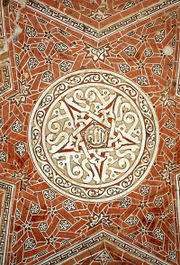

الأربعة والأربعون
For supplementary information see Post-imperial Mongolia
المدخل الثالث للبوذية
النهضة الثقافية
الغزوات الخارجية
الحكم الأجنبي
العصر الحديث

. . . . . . . . . . . . . . . . . . . . . . . . . . . . . . . . . . . . . . . . . . . . . . . . . . . . . . . . . . . . . . . . . . . . . . . . . . . . . . . . . . . . . . . . . . . . . . . . . . . . . . . . . . . . . . . . . . . . . . . . . . . . . . . . . . . . . . . . . . . . . . . . . . . . . . . . . . . . . . . . . . . . . . . .
الديموقراطية
انظر أيضا
- منغوليا
- منغوليا قبل جنكيز خان
- اقليم منغوليا العظمى
- تسلسل زمني للتاريخ المنغولي
- البوذية في منغوليا
- عمارة منغوليا
- الثورة الديموقراطية المنغولية 1990
- Architecture of Mongolia
- Central Asian studies
- Culture of Mongolia
- جغرافيا منغوليا
- History of Central Asia
- تاريخ شرق آسيا
- List of sovereign states by date of formation
- List of country name etymologies
- Mongolian nobility
- الهضبة المنغولية
- Outline of Mongolia
- سياسة منغوليا
- Timeline of Mongolian history
المصادر
- ^ الموسوعة المعرفية الشاملة
- ^ Хүрээлэнгийн эрдэм шинжилгээний ажлын ололт амжилт, Institute of Mongolian Archaeology Archived 2013-12-26 at the Wayback Machine
- ^ أ ب ت Eleanora Novgorodova, Archäologische Funde, Ausgrabungsstätten und Skulpturen, in Mongolen (catalogue), pp. 14-20
- ^ Davaadorzhiĭn Ganbold, Da Haliun – Facts about Mongolia, p.34
- ^ Tumen D., "Anthropology of Archaeological Populations from Northeast Asia Archived 2013-07-29 at the Wayback Machine" (PDF) pages 25, 27
- ^ "The Mysterious Scythians Burst Into History". United Church of God. Archived from the original on 2011-04-24.
- ^ SPIEGEL ONLINE, Hamburg, Germany (25 August 2006). "Archeological Sensation: Ancient Mummy Found in Mongolia". SPIEGEL ONLINE.
{{cite web}}: CS1 maint: multiple names: authors list (link) - ^ أ ب "Altaic languages". Encyclopædia Britannica.
- ^ أ ب "Mongolia - Early Development, ca. 220 B.C.-A.D. 1206".
- Walther Heissig, Claudius Müller, Die Mongolen (exhibition catalogue), Munich 1989 (as Mongolen (catalogue))
وصلات خارجية
- History of Mongolia - Offers a history of Mongolia from 1203 to the present.
- Map of the Capital Districts of the Kidan Empire
- Map of the Kidan period
- Kidans and Jurjens
- Dual Manichaeism in Uighuria and Iran
- Realm of the Mongols
- Mongolia - Entry on Mongolia from the 1907 Catholic Encyclopedia
- Biography of Zanabazar and history of dissemination of Buddhism in Mongolia by Don Croner





